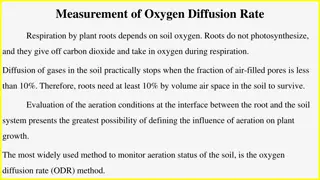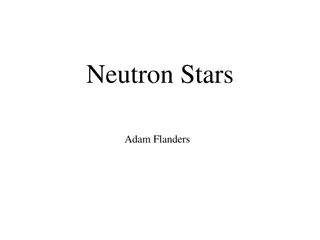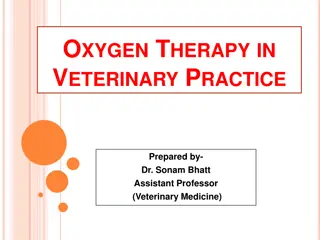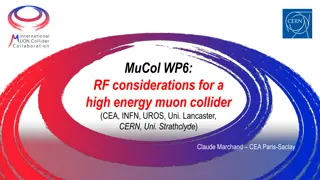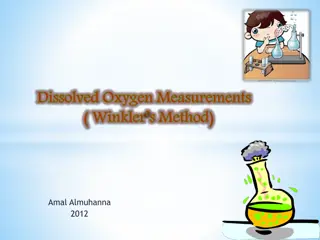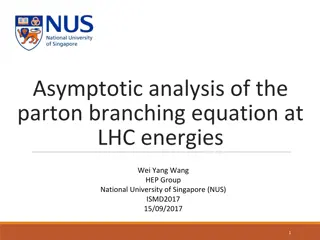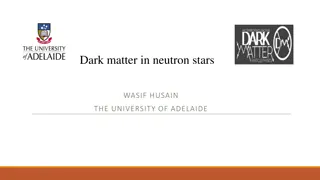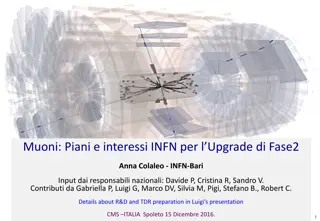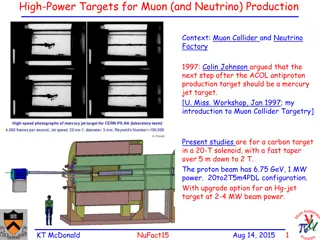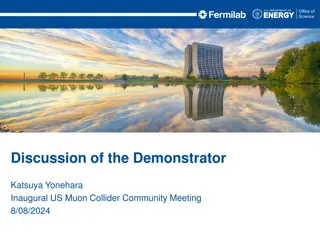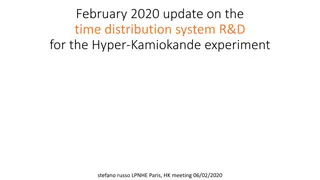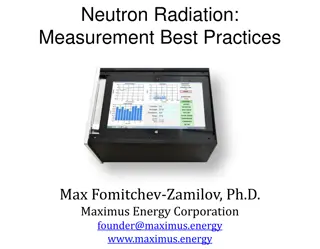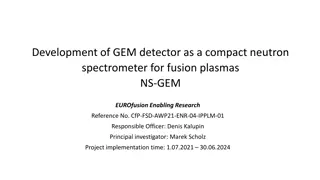Neutron Multiplicity Measurement in Muon Capture on Oxygen in Super-Kamiokande
Explore the neutron multiplicity measurement in muon capture on oxygen using Super-Kamiokande, a water-Cherenkov detector located underground in Japan. Gadolinium was added to enhance neutron tagging efficiency, aiding in Supernova observation, proton decay rejection, and more. Neutron signals are tagged using a neural network, while atmospheric neutrino events are analyzed for oscillation. The talk delves into the processes involved in muon capture on oxygen and its significance in event reconstruction.
Download Presentation

Please find below an Image/Link to download the presentation.
The content on the website is provided AS IS for your information and personal use only. It may not be sold, licensed, or shared on other websites without obtaining consent from the author.If you encounter any issues during the download, it is possible that the publisher has removed the file from their server.
You are allowed to download the files provided on this website for personal or commercial use, subject to the condition that they are used lawfully. All files are the property of their respective owners.
The content on the website is provided AS IS for your information and personal use only. It may not be sold, licensed, or shared on other websites without obtaining consent from the author.
E N D
Presentation Transcript
1 Neutron multiplicity measurement Neutron multiplicity measurement in muon capture on oxygen in muon capture on oxygen in SK in SK- -Gd Gd Sep. 17, 2022 @Erice school Shintaro MIKI (ICRR, Univ. of Tokyo) smiki@km.icrr.u-tokyo.ac.jp
2 Super Super- -Kamiokande Kamiokande 1000m underground Water-Cherenkov detector @Kamioka mine, Japan. 50 kton pure water + ~11,000 50cm PMTs Aims mainly for ? observation & proton decay. Cherenkov radiation 41.4 m ? ? typical ??event 39.3 m
n 3 SK SK- -Gd project Gd project Gd p ?? Gadolinium was added to SK water to enhance neutron tagging efficiency. ? + total 8MeV Gd Gd capture fraction Year concentration ? ~ ?(100 s) ? ~ ?(100 cm) 1996 - 2020 0% 0% 2020 - 2022 0.01% 50% 2022 - ongoing 0.03% 75% Benefits: ? / ? discrimination Supernova diffuse ? search and pointing accuracy Proton decay BG rejection Goal 0.1% 90% The others end in p(n,?) with 2.2-MeV ? This talk mainly focuses on this period.
4 Neutron signals in SK Neutron signals in SK- -Gd Gd Neutron signals are tagged with neural network. Tagged neutrons in atmospheric neutrino events Gd(n,?) , p(n,?) , Michel-e (normalized by num. of signals) signal + Data points more energetic more isotropic shorter lived
5 Atmospheric neutrino oscillation Atmospheric neutrino oscillation ? SK Sensitive to mass ordering, ???, and ?23. Important: Energy resolution, Direction resolution, and ? / ? discrimination ? or ? (??) 1 downgoing ?(?? ??) ?(?? ??) air cosmic rays 0.5 cos? 0 -0.5 Resonance only in ? ( ?) if NO (IO) upgoing -1 10 (Assume NO) 100 1 10 100 ??[GeV] 1
6 Neutrons for atmospheric neutrino Neutrons for atmospheric neutrino Neutron information can be used for event reconstruction: More neutrons in ? events than ?. ?/ ? discrimination Invisible energy is larger as more neutrons are produced. ??resolution ??is estimated from its displacement. ??, ??resolution n n ... 16O Muon capture is one important process for ? production. ? +16O N + ??+ n + n + 16O ? Muon capture (This talk) ... How many neutrons ? Neutrino interaction n n
7 What we know about muon capture on What we know about muon capture on 16 16O O Neutron emission Neutron is emitted if excited nuclei has enough energy. Neutron emission Otherwise, de-excited to ground state by gamma emission. 14N 15N 16N 16O (? ,??)
8 What we know about muon capture on What we know about muon capture on 16 16O O Neutron emission 2n + ~2MeV ? Gamma emission and neutron multiplicity have been measured. 1n + ~6MeV ? 0.8% Neutron emission Each rate has large uncertainty. 67 8 % 0.8 0.4 % etc 14N 67% >5 MeV ? just 1 neutron 0n + ?(100)keV ? 1n + 0? We measured neutron multiplicity with cosmic ray stopping muons in SK-Gd. First direct measurement of multiplicity 4? coverage & ~50% neutron efficiency 21% 15N 11% 16N 16O (? ,??)
9 Tagging efficiency calibration Tagging efficiency calibration Measure neutron tagging efficiency by preparing 1-neutron control sample. Muon capture events with >5 MeV ? cosmic ray ? m Events /5 150 s from fit 100 50 0 0 SK 100 Efficiency In events with ? 200 N(tagged n) Fit: ?exp( ? ?) + ? n = 300 N(gamma) B B t t N N 2c / ndf 2c / ndf Capture time [ 16O = 46.1% 400 2.856 2.856 3396 3396 107.6 / 100 107.6 / 100 109.3 109.3 (>5 MeV) 0.658 0.658 87.6 87.6 500 4.0 4.0 Neutron capture time [ s] s] m
10 Neutron multiplicity measurement Neutron multiplicity measurement Measured in cosmic ray stopping muon events (livetime: 215.5 days). Num of muon capture is statistically estimated to be 1 766892 Num of muons ? capture prob 0.184 = 53539 1+1.37 ?+/? ratio In stopping muon events with no tagged decay-e: Num of tagged neutrons /event 0 1 2 3 4 5 Num of events 333151 27505 1374 51 1 1 3 3 Ratio 92% 7.6% 0.4% 0.014% 10 4% 10 4%
11 Correction for multiplicity Correction for multiplicity Measured multiplicity is distorted by tagging efficiency & mis-tagged signals: True multiplicity ?0 ?1 ?2 ... Distorted by efficiency ? N0= ?0+ ?11 ? + ?21 ?2+ ?31 ?3+ (? = 46.1%) N1= ?1? + 2?2? 1 ? + 3?3? 1 ?2+ Add mis-tagged signals Obs0 ?01 ? (rate: ? = 0.017 signals /ev) Obs1 ?11 ? + ?0? Inversely, get ??from Obsi. Reduce num of 0n events to meet with expected num of capture events. (for the remaining decay-e events)
12 Multiplicity result Multiplicity result Num of produced neutrons /capture 0 1 2 3 4 5 120 9468 45495 4188 461 47 Num of events 76 4 % probability 0.6 16% 76% 7.0% 0.8% 0.08% 0.2 Ratio 0.4 0.8 # of neutrons /capture 0 Largest uncertainty source is tagging efficiency for n=0,1,2 statistics for n 3 Consistent with results in pure-water SK (just before Gd) - low stat, low efficiency 16 4 % 0 0.08 0.08 % 1 2 7.0 0.7 % 0.8 0.3 % pure water SK-Gd < 0.2 % 3 4 5
13 Summary and prospects Summary and prospects Atmospheric neutrino study is conducted by using upgraded SK-Gd aiming at mass ordering determination, ???measurement and ?23octant. First direct measurement of neutron multiplicity in muon capture on 16O : ? 0 = 16 4 % , ? 1 = 76 4 % , ? 2 = 7.0 0.7% ? 3 = 0.8 0.3% , ? 4 < 0.2% , ? 5 = 0.08 0.08% Neutron tagging efficiency in SK-Gd is determined to be 46.1%. New neutrino reconstruction algorithm with neutron position and multiplicity is under development to enhance the physics sensitivity.
14 Back up Back up
15 Neutron multiplicity in atmospheric Neutron multiplicity in atmospheric ? events events Less neutrons are tagged in data especially in low energy events.
16 Neutron tagging performance Neutron tagging performance 20 Tagging efficiency [%] We have two mode for neutron tagging: High-efficiency mode Assume neutron capture vertex is same as generation vertex. Less-biased mode Neutron capture vertex is used in the algorithm. p(n,?) 10 0 100 80 Neutron tagging efficiency: 60 p(n,?) 19.9% 5.4% Gd(n,?) 94.0% 83.3% overall Gd(n,?) High-efficiency Less-biased 57.5% 44.9% 40 20 0 100 200 300 400 Neutron travel distance [cm]


